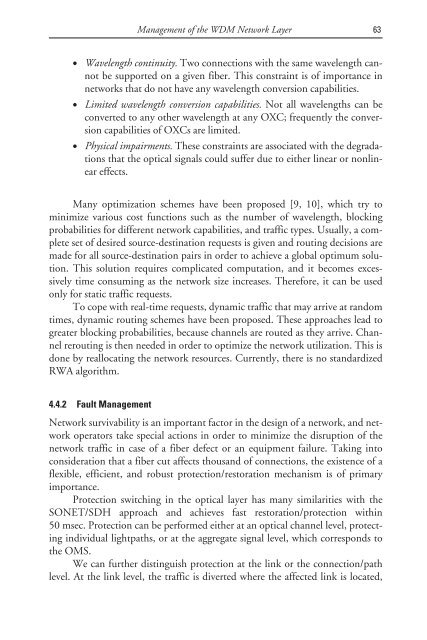deploying and managing ip over wdm networks - Index of
deploying and managing ip over wdm networks - Index of
deploying and managing ip over wdm networks - Index of
Create successful ePaper yourself
Turn your PDF publications into a flip-book with our unique Google optimized e-Paper software.
• Wavelength continuity. Two connections with the same wavelength cannot<br />
be supported on a given fiber. This constraint is <strong>of</strong> importance in<br />
<strong>networks</strong> that do not have any wavelength conversion capabilities.<br />
• Limited wavelength conversion capabilities. Not all wavelengths can be<br />
converted to any other wavelength at any OXC; frequently the conversion<br />
capabilities <strong>of</strong> OXCs are limited.<br />
• Physical impairments. These constraints are associated with the degradations<br />
that the optical signals could suffer due to either linear or nonlinear<br />
effects.<br />
Many optimization schemes have been proposed [9, 10], which try to<br />
minimize various cost functions such as the number <strong>of</strong> wavelength, blocking<br />
probabilities for different network capabilities, <strong>and</strong> traffic types. Usually, a complete<br />
set <strong>of</strong> desired source-destination requests is given <strong>and</strong> routing decisions are<br />
made for all source-destination pairs in order to achieve a global optimum solution.<br />
This solution requires complicated computation, <strong>and</strong> it becomes excessively<br />
time consuming as the network size increases. Therefore, it can be used<br />
only for static traffic requests.<br />
To cope with real-time requests, dynamic traffic that may arrive at r<strong>and</strong>om<br />
times, dynamic routing schemes have been proposed. These approaches lead to<br />
greater blocking probabilities, because channels are routed as they arrive. Channel<br />
rerouting is then needed in order to optimize the network utilization. This is<br />
done by reallocating the network resources. Currently, there is no st<strong>and</strong>ardized<br />
RWA algorithm.<br />
4.4.2 Fault Management<br />
Management <strong>of</strong> the WDM Network Layer 63<br />
Network survivability is an important factor in the design <strong>of</strong> a network, <strong>and</strong> network<br />
operators take special actions in order to minimize the disruption <strong>of</strong> the<br />
network traffic in case <strong>of</strong> a fiber defect or an equ<strong>ip</strong>ment failure. Taking into<br />
consideration that a fiber cut affects thous<strong>and</strong> <strong>of</strong> connections, the existence <strong>of</strong> a<br />
flexible, efficient, <strong>and</strong> robust protection/restoration mechanism is <strong>of</strong> primary<br />
importance.<br />
Protection switching in the optical layer has many similarities with the<br />
SONET/SDH approach <strong>and</strong> achieves fast restoration/protection within<br />
50 msec. Protection can be performed either at an optical channel level, protecting<br />
individual lightpaths, or at the aggregate signal level, which corresponds to<br />
the OMS.<br />
We can further distinguish protection at the link or the connection/path<br />
level. At the link level, the traffic is diverted where the affected link is located,


